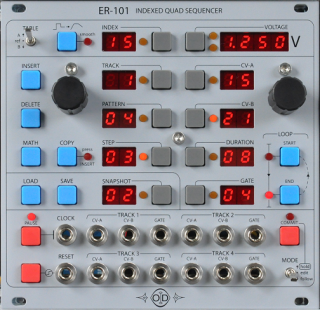This video, via Orthogonal Devices, demonstrates advanced probabilistic sequencing with their ER-101 Indexed Quad Sequencer & ER-102 Sequencer Controller.
Here’s what they have to say about the demo:
A user asked on the forums how o ne can introduce probabilities into the ER-101/102 sequencing and thus this video was made to explain one method. The video is a quick tutorial on how to have individual steps trigger (or not) according to a (per-step) probability.
ne can introduce probabilities into the ER-101/102 sequencing and thus this video was made to explain one method. The video is a quick tutorial on how to have individual steps trigger (or not) according to a (per-step) probability.
You can do this with the non-destructive transforms of the ER-102 groups because these transforms get re-evaluated every time the step is played. The trick is to get the ER-101/102 to threshold the output of the random operators. In other words, to get different probabilities just use the fact that parameters are clamped to be at least greater than zero and then combine the subtract operation with either the jitter (jt) operation or the (rd) operation.
For example, suppose we have 8 steps that are all the same DURATION=16 but have the following TRIGGER lengths (i.e. GATE lengths but track is set to TRIGGER mode):
1. 21
2. 0
3. 8
4. 6
5. 21
6. 0
7. 15
8. 5
Then we add these steps to GROUP #1 and set the X/LOW transform of GROUP #1 to
A = -20 (i.e. subtract 20)
rd = 20 (i.e. add a random number between 0 and 20)
The steps with the larger TRIGGER lengths will have a higher probability of being greater than zero after the group transform is applied. This way you can set the effective probability of a non-zero TRIGGER length per-step. In the example above, steps 1, and 5 will always fire but steps 2 and 6 will never fire. The other steps will fire with probability proportional to their TRIGGER length with anything greater than 20 having 100% probability. It’s quite fun and allows you to create ever changing rhythms that nevertheless have a clear groove, in fact any groove that you want. Finally, you can use the MOD bus to control the “probabilities” with external CV.
For details on the Orthogonal Devices sequencer modules, see their site.

Wow, seems quite interesting. True borderline between engineering and “standard” synth sound design.
Reminds me of the Triadex Muse in a limited way. There is a VST Muse by Paul Geffen and modded by Steven Parker out there if you want to look for it. Musicology for the geeky genius.
Nah
I would love to see this video with captions. He talks too fast and doesn’t enunciate his speech. Probably I’m not mathematical enough either but I cant help wondering what this thing can capably do.
basically all he does is adjusting probability per step which is really cool and would take ages to do on regular hardware sequencers.
This is interesting and stuff, but – there are some things that are probably best left to software, and I think this is one of them.
I wonder how easy it would be reproduce this type of process with Numerolgoy 4 Pro
This looks really useful for the type of things I like to do. Another thing pulling me into modular.